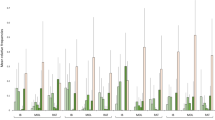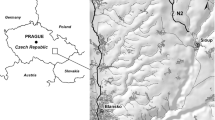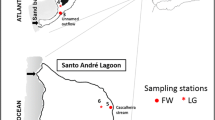Abstract
Coastal lagoons are at risk internationally due to impacts associated with human-induced land use change. The resilience of aquatic macrophytes in these systems is threatened by altered hydrological regimes, elevated nutrient loading, and increased dominance of nuisance species. We describe the aquatic plant dynamics of the Waituna Lagoon Ramsar Site, a 1,350 ha lagoon frequently opened to the sea for flood mitigation which is characterised by fluctuating water levels and salinity. The shallow lagoon supports a macrophyte community dominated by Ruppia megacarpa and R. polycarpa. Repeated survey of 48 sites across the lagoon during late summer in 2009, 2010 and 2011 were applied to describe aquatic plant composition and abundance. This period coincided with three opening events (winter 2008; winter 2009; spring 2010) when the lagoon switched from a predominantly fresh-brackish system to being influenced by tidal exchange and lower water levels. The lagoon experienced a period of 43 days open to the sea in 2008–2009, 67 days in 2009–2010 and 181 days in 2010–2011, during which macrophytes were subject to saline conditions in excess of 10 ppt. We observed a decline in the occurrence of Ruppia from 2009 (69 % sites) to 2011 (23 % sites). The shift in productivity was associated with the duration of the open phase and the period plants were subject to saline conditions >20 ppt and low water levels. The resilience of the system is also at risk from increased algal-dominance due to the intensification of agricultural land use occurring in the Waituna Lagoon catchment. While lagoon opening events cause extreme changes in water depth and salinity that can limit macrophyte growth, they also provide a mechanism to reduce the effects of eutrophication. Understanding these trade-offs is pivotal in management decisions regarding the likely impact of opening events on the ecological character of coastal lagoons.





Similar content being viewed by others
References
Adams JB, Bate GC (1994) The tolerance to desiccation of the submerged macrophytes Ruppia cirrhosa Petagna (Grande) and Zostera capensis Setchell. J Exp Mar Biol Ecol 183:53–62
ANZECC, ARMCANZ (2000) Australian and New Zealand Guidelines for Fresh and Marine Water Quality, Australian and New Zealand Environment and Conservation Council (ANZECC) and Agriculture and Resource Management Council of Australia and NewZealand (ARMCANZ), Canberra
Atkinson EP (2008) What’s lurking in the Waituna wetlands? A freshwater fish survey: Arawai Kakariki Project. Department of Conservation, Invercargill
Australian Water Environments (2003) Murray Darling Basin Commission Living Murray Initiative. Lower Lakes and Coorong. Regional Evaluation Group Assessment Report to the Scientific Reference Panel, Murray Darling Basin Commission, Canberra
Brock MA (1982a) Biology of the salinity tolerant genus Ruppia L. in saline lakes in South Australia I. Morphological variation within and between species and ecophysiology. Aquat Bot 13:219–248
Brock MA (1982b) Biology of the salinity tolerant genus Ruppia L. in saline lakes in South Australia. II. Population ecology and reproductive biology. Aquat Bot 13:249–268
Carruthers TJB, Walker DI, Kendrick GA (1999) Abundance of Ruppia megacarpa Mason in a seasonally variable estuary. Estuar Coast Shelf Sci 48:497–509
Casanova MT, Brock MA (1990) Charophyte germination and establishment from the seed bank of an Australian temporary lake. Aquat Bot 36:247–254
Cloern JE (2001) Our evolving conceptual model of the coastal eutrophication problem. Mar Ecol Prog Ser 210:223–253
Comin FA, Menéndez M, Lucena JR (1990) Proposals for macrophyte restoration in eutrophic coastal lagoons. Hydrobiologia 200(201):427–436
Congdon RA, McComb AJ (1979) Productivity of Ruppia: seasonal changes and dependence on light in an Australian Estuary. Aquat Bot 6:121–132
Cosgrove S (2011) Anthropogenic impacts on Waituna Lagoon: reconstructing the environmental history. MSc Thesis, University of Otago, Dunedin
Cronk JK, Fennessy MS (2001) Wetland plants: biology and ecology. CRC Press, Boca Raton
Duggan IC (2010) Consequences of human-mediated marine incursions on the zooplankton community of a temperate coastal lagoon. N Z J Mar Freshw Res 44:17–28
Environment Southland (2009) Lake water quality annual monitoring summary July 2008–June 2009. Report Card published by Environment Southland, Invercargill
Freebairn A (1998) Monitoring of aquatic resources in the southern Coorong. The University of Adelaide, Adelaide
Geddes MC (1987) Changes in salinity and in the distribution of macrophytes, macrobenthos and fish in the Coorong lagoons, South Australia, following a period of River Murray flow. Trans R Soc S Aus 111:173–181
Gerbeaux P (1989) Aquatic plant decline in Lake Ellesmere: a case for macrophyte management in a shallow New Zealand lake. PhD Thesis, Lincoln University, Christchurch
Gerbeaux P (1993) Potential for re-establishment of aquatic plants in Lake Ellesmere (New Zealand). J Aquat Plant Manag 31:122–128
Gerbeaux P, Ward JC (1991) Factors effecting water clarity in Lake Ellesmere, New Zealand. N Z J Mar Freshw Res 25:289–296
Hamilton DP, Mitchell SF (1996) An empirical model for sediment resuspension in shallow lakes. Hydrobiologia 317:209–220
Hughey KFD, Taylor KJW (eds) (2009) Te Waihora/Lake Ellesmere: state of the lake and future management. EOS Ecology, Christchurch
Johnson P, Brooke P (1998) Wetland plants in New Zealand. Manaaki Whenua Press, Lincoln
Johnson P, Partridge TR (1998) Vegetation and water level regime at Waituna Lagoon, Southland. Science for Conservation No 98
Kantrud HA (1991) Wigeongrass (Ruppia maritima L.): a literature review. U.S. Fish and Wildlife Service. Jamestown
Kirk JTO (1994) Light and photosynthesis in aquatic ecosystems, 2nd edn. Cambridge University Press, UK
Kirk RM, Lauder GA (2000) Significant coastal lagoon systems in the South Island, New Zealand. Department of Conservation, Wellington
Morris K, Bailey PC, Boon PI, Hughes L (2003) Alternative stable states in the aquatic vegetation of shallow urban lakes. II. Catastrophic loss of aquatic plants consequent to nutrient enrichment. Mar Freshw Res 54:201–215
Moss B (1990) Engineering and biological approaches to the restoration from eutrophication of shallow lakes in which aquatic plant communities are important components. Hydrobiologia 200(201):367–377
Nicol J (2005) The ecology of Ruppia spp. In: South Australia, with reference to the Coorong. South Australian Research and Development Institute (Aquatic Sciences), Adelaide. SARDI Aquatic Sciences Publication Number RD04/0247-2
Nielsen DL, Brock MA, Rees GN, Baldwin DS (2003) Effects of increasing salinity on freshwater ecosystems in Australia. Aus J Bot 51:655–665
Paton DC (2001) Monitoring biotic resources in the Coorong, January 2001. The University of Adelaide, Adelaide
Paton DC, Bolton J (2001) Monitoring aquatic resources in the southern Coorong in winter 2000. The University of Adelaide, Adelaide
Riddin T, Adams JB (2009) The seed banks of two temporarily open/closed estuaries in South Africa. Aquat Bot 90:328–332
Robertson B, Stevens L (2007) Waituna Lagoon 2007: macrophyte (Ruppia) mapping. Report prepared for Department of Conservation, Wriggle Coastal Management, Nelson
Robertson H, Atkinson E, Chesterfield S, Suggate R (2009) Awarua Wetland: New Zealand. In: WWT (ed) Ramsar sites of the world. Ministry of Environment, Korea
Robertson B, Stevens L, Schallenberg M, Robertson H, Hamill K, Hicks A, Hayward S, Kitson J, Larkin G, Meijer K, Jenkins C, Whaanga D (2011) Interim recommendations to reduce the risk of Waituna Lagoon flipping to an algal-dominated state. Environment Southland, Invercargill
Rogers DJ, Paton DC (2009) Changes in the distribution and abundance of Ruppia tuberosa in the Coorong. CSIRO: Water for a Healthy Country National Research Flagship, Canberra
Sanders HL (1968) Marine benthic diversity: a comparative study. Am Nat 102:243–282
Schallenberg M, Sorrell B (2009) Regime shifts between clear and turbid water in New Zealand lakes: environmental correlates and implications for management and restoration. N Z J Mar Freshw Res 43:701–712
Schallenberg M, Tyrell C (2006) Report on risk assessment for aquatic flora of Waituna Lagoon. Department of Conservation, Wellington
Schallenberg M, Larned ST, Hayward S, Arbuckle C (2010) Contrasting effects of managed opening regimes on water quality in two intermittently closed and open coastal lakes. Est Coast Shelf Sci 86:587–597
Scheffer M (1998) Ecology of shallow lakes. Chapman & Hall, London
Scheffer M, van Nes EH (2007) Shallow lakes theory revisited: various alternative regimes driven by climate, nutrients, depth, and lake size. Hydrobiologia 584:455–466
Scheffer M, Carpenter S, Foley JA, Folke C, Walker B (2001) Catastrophic shifts in ecosystems. Nature 413:591–596
Schwarz A-M, de Winton M, Hawes I (2002) Species-specific depth zonation in New Zealand charophytes as a function of light availability. Aquat Bot 72:209–217
Silk N (2005) The global challenge of freshwater biodiversity conservation. In: Silk N, Ciruna K (eds) A practitioner’s guide to freshwater biodiversity conservation. Island Press, Washington DC
Sim L, Chambers J, Davis J (2006) Ecological regime shifts in salinised wetland systems. I. Salinity thresholds for the loss of submerged macrophytes. Hydrobiologia 573:89–107
Squires MM, Lesack LFW, Huebert D (2002) The influence of water transparency on the distribution and abundance of macrophytes among lakes of the Mackenzie Delta, western Canadian arctic. Freshw Biol 47:2123–2135
Thompson RM, Ryder GR (2003) Waituna lagoon: summary of existing knowledge and identification of knowledge gaps. Science for Conservation No 215
Viaroli P, Bartoli M, Giordani G, Naldi M, Orfanidis S, Zaldivar JM (2008) Community shifts, alternative stable states, biogeochemical controls and feedbacks in eutrophic coastal lagoons: a brief overview. Aqu Cons: Mar Freshw Ecosys 18:S105–S117
Waghorn R, Thomson R (1989) Looking back. Kapuka South and Lake Waituna. Kapuka South Jubilee Committee, Invercargill
Walker DI, McComb AJ (1992) Seagrass degradation in Australian coastal waters. Mar Poll Bull 25:191–195
Acknowledgments
This project was funded by the Department of Conservation (DOC) Arawai Kākāriki Wetland Restoration Programme. Wriggle Coastal Management (2009; 2010) and the National Institute of Water and Atmospheric Research (2011) implemented the field programme. Colleagues from DOC and Environment Southland provided field support and supplied data on water quality and lagoon hydrology. David Kelly assisted with analysis of light limitation. We appreciated comments from Philippe Gerbeaux, Eric Edwards, Eduardo Villouta, two anonymous reviewers and the associate editor on earlier versions of the manuscript.
Author information
Authors and Affiliations
Corresponding author
Rights and permissions
About this article
Cite this article
Robertson, H.A., Funnell, E.P. Aquatic plant dynamics of Waituna Lagoon, New Zealand: trade-offs in managing opening events of a Ramsar site. Wetlands Ecol Manage 20, 433–445 (2012). https://doi.org/10.1007/s11273-012-9267-1
Received:
Accepted:
Published:
Issue Date:
DOI: https://doi.org/10.1007/s11273-012-9267-1




